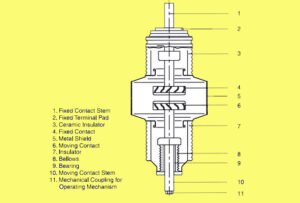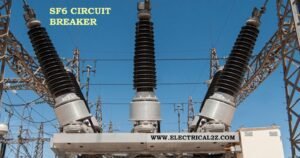What is Air Blast Circuit Breaker?
This air blast circuit breaker has been used earlier for open terminal HV application, for system voltages of 245 kV, and 400 kV up to 765 kV, especially where faster breaker operation was required. In the later design, a two-cycle operation was achieved and even faster operating systems with a total break time of one cycle have been developed for special applications in American grids.
In this special design, the mechanical opening time of 12 ms and maximum arcing time of about 8 ms has been achieved. This type of breaker has been used for special applications wherein several super thermal power stations located in close vicinity to each other have been inter-connected.
These one cycle breakers form the inter-connecting link which, in the event of a fault in an outgoing feeder of a particular station, isolates the station from the neighboring ones thereby limiting the fault level for the feeder breaker.
Other Types of Circuit Breakers:
It has long been recognized that short line fault duty is a major problem with air blast breakers, especially where the fault current is high. Earlier tripping resistors were used to damp the short line fault oscillations.
Later on, a better understanding of arc and model studies made it possible to develop air blast breakers without the aid of damping resistors. However, till today, this duty continues to be the most critical and usually dictates the number of interrupters to be used per pole for a particular fault rating.
Picture shows the construction of a typical air blast interrupter. Each interrupter consists of a porcelain insulator, mounted on the air inlet manifold, with the exhaust chamber fixed at the opposite end of the porcelain. The exhaust chamber consists of a casting with a curved hood for weather protection and slots on the underside for directional exhaust of the compressed air to atmosphere.
The moving contact assembly consists of a chromium-copper contact coupled to two pistons by means of an insulated tie rod that moves inside the contact tube. The main current in the moving contact is transferred to the contact tube by means of transfer contact fingers.
An arcing tip is provided at the end of the moving contact. The moving contact is maintained in a normally closed position with the fixed contact by springs. The details of construction of the interrupter head vary with its interruption rating. Image shows the closed position of interrupter. Picture shows contacts in partially open position with arcing between fixed and moving contact. Image shows contacts in full open position with arc extinguished.
 |
| Contacts closed – Air blast commencing Arc struck |
The interrupting capability of air blast circuit breaker is usually increased by increasing the normal pressure range. Normally the pressure level is around 30 to 35 bars. In order to maintain the insulation level and reliability of operation, it is also necessary for the condition of the air to be very dry. Currently, however, SF6 circuit breakers have practically eliminated the use of this technology.
Final Word
Hope you understand this article about Air Blast Circuit Breakers | ABCB. Incase of any doubt please comment below. Subscribe our website to get every new post update to your email. Please follow our website – ElectricianWorld.net for future updates. Thank you for visiting our website.



